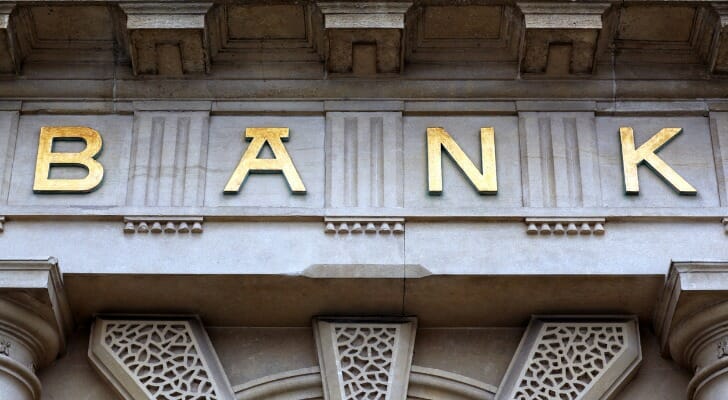A bank branch is a physical location of a banking corporation, such as Bank of America or Wells Fargo. These buildings are technically referred to as “brick-and-mortar” branches, and they provide face-to-face service for customers of a bank. Branches customarily feature mortgage officers, financial advisors and other professionals as well, something that modern-day online banking currently cannot deliver. Read on to learn more about bank branches and if you should specifically join a bank that operates them.
What Is a Bank Branch?
If you’ve opened a bank account at some point during your life, you’ve probably set foot in a bank branch. A bank branch typically consists of a collection of tellers who can aid you in withdrawing money, depositing checks and cash and more. Many Americans prefer the in-person service a bank branch can offer, as it can be frustrating to deal with phone- and email-based customer service representatives. Branches can also be especially helpful if you’re applying for a loan, opening an investment portfolio or making any number of other important financial decisions.
Bank branches began receiving the brick-and-mortar title, because that’s what they were quite literally made of. While this terminology only became necessary due to the rise of web-based banks, branches still exist all over the country. However, according to the Wall Street Journal, there has been a sharp nationwide rise in the number of branches being closed by banks. For example, Capital One shut down 32% of its branches from mid-2012 to mid-2017.
In its most basic form, banking has been around for thousands of years, with historians crediting the Mesopotamians, Sumerians, Babylonians and other ancient cultures with this financial advancement. Branches, or institutions similar to them, didn’t begin appearing until the Roman Empire’s reign, though. From then on, bank branches popped up around the world, most notably in Italy, England and the U.S.
Common Services You Can Find at a Bank Branch

A bank branch, or rather a widespread network of them, offers benefits to both customers and the bank itself. Not only does this allow customers to stop somewhere to have their needs met, but it also raises awareness for the bank’s brand and, in the end, boosts its revenues and profits. If you visit a branch, here are services you are likely to find:
Perhaps the most basic interaction you’ll have at a bank branch is either the withdrawal or deposit of money. Branches will usually have a small table when you walk in where you can grab withdrawal slips, deposit slips and other paperwork necessary to complete a transaction. Although this may seem like an inconvenient alternative to the simplicity of an ATM, these machines tend to have withdrawal limits, whereas tellers do not.
If you have a ton of coins and aren’t sure what to do with them, bank branches will almost always house some sort of coin counting machine. Once you know how much your coins are worth, bring the receipt to a teller to get cash for their value. Check with your bank to see if they offer this service.Banks have many protections in place to ensure that their money is not stolen. So it should come as no surprise that banks often have safety deposit boxes available for customers. These are strictly accessible through bank branches, although you’ll likely need to pay an annual fee for them.
Who Uses Bank Branches?
Although major banks are reducing the number of branches they operate, most people and businesses still patronize these physical locations. A 2016 Federal Reserve report on a survey of individual banking customers found large majorities visited bank branches, despite the availability of increasingly flexible and convenient online services. Wealthier and self-employed people were more likely to use branches and high earners, the survey found.
Local branches also serve small businesses seeking loans. The same survey found that the share of small lenders without a branch presence was below 20 percent in urban markets. Small business borrowers in rural markets were somewhat more likely to get loans from banks that lacked brick-and-mortar presences in their communities. But local branches still play an important role in small business lending, the Fed found.
Branchless Alternatives to Brick-and-Mortar Banks
With the dawn of the age of the internet, online banks have become increasingly popular. Some companies have even taken this idea a step further by establishing banks based entirely within the confines of a mobile app. Common names in this growing market are Ally Bank, Chime Bank and Axos Bank.
If you’re skeptical about banking with a company that has no brick-and-mortar locations, you’re not alone. These banks, however, have come up with some enticing ways to attract new customers. For example, the four banks listed above come with nonexistent or extremely low fee schedules and minimum opening deposits. But perhaps even better than these perks are the superior interest rates you’ll find with them.
Nothing in finance comes without its downsides, though. One of the most prominent issues with online/mobile banks is that they often lack widespread account choice. This is because internet banks mostly stick to checking and savings accounts, while occasionally dabbling in money market accounts (MMAs). That means you typically won’t be able to get a certificate of deposit (CD) or an individual retirement account (IRA).
Brick-and-Mortar vs. Online Banks
Banks with physical branches and online-only banks each have pros and cons. Their very different business models and methods of delivering services mean that they also have very different pluses and minuses.
Online banks offer 24/7 access every day of the year. It is also quick and easy to open an account. In many cases, you can open an online account before you can drive to the nearest bank branch. Higher interest rates are ordinarily offered by online banks. And fees as well may be lower and fewer when you bank online.
On the downside, an online bank is inaccessible when the inevitable technical outage occurs. This frustrating blockage may last hours and in some cases even longer. A multiplying factor is that online banks tend to have fewer ATMs you can use as backup when the online connection is down. Another issue is that you can’t make cash deposits to online banks. Online banks also provide limited customer service, and you can’t ever meet a representative face to face.
Physical bank branches offer human service representatives you can meet with in person, providing a personalized feel no online bank can match. They also tend to offer more services, such as mortgages, and can handle a broader range of transaction types. You can make cash deposits, and usually enjoy a bigger ATM network than an online competitor.
Bank branches’ limitations include being open for business only during limited hours. If you catch the branch open, you may have to wait in a long line to complete your business. Fees are usually higher, and opening an account is less convenient. Finally, bank branches are likely to pay lower interest rates.
A Bank With Branches or Not: Which Should You Join?

When deciding between an online-only bank and a traditional bank with branches, it helps to think about whether having the option to visit a branch matters to you. Choosing a bank with branch access might mean giving up some of the benefits online banks offer, like higher interest rates or lower fees. Still, many people prefer having the ability to go to a branch if needed, and most Americans continue to favor banks with physical locations.
Tips for Navigating the Banking Industry
- If you’re interested in joining a new bank, it might be worthwhile to consult an advisor. Finding the right financial advisor that fits your needs doesn’t have to be hard. SmartAsset’s free tool matches you with vetted financial advisors who serve your area, and you can have a free introductory call with your advisor matches to decide which one you feel is right for you. If you’re ready to find an advisor who can help you achieve your financial goals, get started now.
- Research is the key to success in finance, and banking is no different. If you’re in search of a new bank, be sure to include as many choices in your comparisons as possible. Even though something like an online-only bank might seem too far-fetched, it could be well worth looking into.
Photo credit: ©iStock.com/YinYang, ©iStock.com/BrianAJackson, ©iStock.com/MATJAZ_SLANIC
